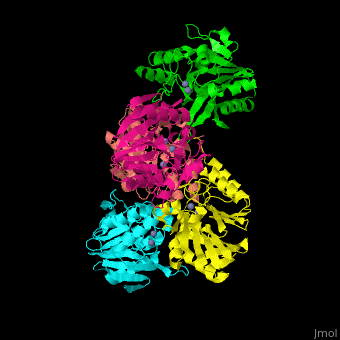From Proteopedia
proteopedia linkproteopedia link |
Function
Beta-lactamase (Blac) are enzymes which make bacteria resistant to β-lactam antibiotics by breaking their β-lactam ring. Blac are classified according to their resistance targets.
- Class A are broad-spectrum. See also TEM1 Class Antibiotic Resistance Proteins.
- Class B are metalloenzymes.
- Class C are cephalosporinases. See also Class C beta-lactamase.
- Class D are cloxacilanases
- Carbapenemase (Car) are Blac with wide hydrolytic capacities. Car can hydrolyze penicillins, cephalosporins, monobactams and carbapenems.
- Extended-spectrum Blac class A (ESBL) hydrolyze penicillins but not cephalosporins.
Relevance
Blac makes some bacteria resistant to antibiotics like penicillin, cephamycin and carbapenems.
Structural highlights
The .[1]
3D Structures of Beta-lactamase
Beta-lactamase 3D structures
|
3D Structures of Beta-lactamase
Updated on 14-April-2019
2aio – StmBlac B + antibiotic
3q6x, 4ey2, 4eyb, 4eyf, 4efl, 4hl1, 4hl2, 4eyl, 4hky, 4ram, 4raw, 4rbs, 4rl0, 4rl2, 5of2, 5o2e – KpBlac B Ndm-1+ antibiotic
References
- ↑ King D, Strynadka N. Crystal structure of New Delhi metallo-beta-lactamase reveals molecular basis for antibiotic resistance. Protein Sci. 2011 Sep;20(9):1484-91. doi: 10.1002/pro.697. Epub 2011 Aug, 2. PMID:21774017 doi:10.1002/pro.697

